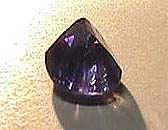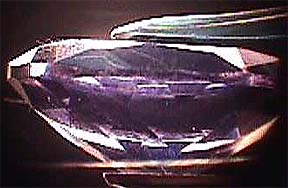A free gemology reference site
Gemology, gemstones, minerals and more
The Gemstones
Iolite
Consumer Information
What color is it?: Blue. And many times a nicer blue than you see above. But sometimes gemology teachers have to take what we can afford.
What is the story behind this gemstone?: Iolite has a pleasing color of blue, but a rather extraordinary optical property that we will discuss further down this page.
Can I wear it everyday?: Generally yes. But it will wear as a necklace or pendant better than a ring.
Is it expensive?: Not really. About the same as a nice amethyst in a good color.
Is it a birthstone?: No.
What do I need to know before going shopping?: It is very important to look at an iolite from several directions before you purchase because the stone will present very different colors from different angles. If cut properly the stone will show its best blue color through the top or table of the stone. But viewed from another angle the stone may appear colorless. That is the strange optical property that I was talking about above. Look below to find out why.
-



-
Untouched color photographs of iolite in various positions to show pleochroism
-


-
Another look at the diagnostic dichroscope reaction of iolite....Note the line of the London dichroscope is visible just above the lower tweezer tong in the photograph at left.
General Information
Source: Brazil, Burma and India are important sources
Chemical: Mg2Al3(AlSi5O18) magnesium aluminum silicate
Formation: Igneous rocks and pegmatite intrusions
Crystal System: Orthorhombic
Unusual Properties: As shown above, iolite has extreme pleochroism with great differences of color from various angles. Turning the stone can almost make it go from deep blue to colorless. Care must be taken when cutting the stone to present the best color through the table (top) of the stone.

